Related Research Articles
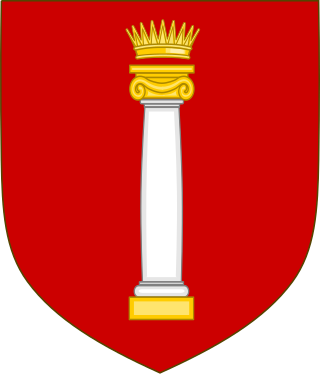
The House of Colonna, also known as Sciarrillo or Sciarra, is an Italian noble family, forming part of the papal nobility. It was powerful in medieval and Renaissance Rome, supplying one pope and many other church and political leaders. The family is notable for its bitter feud with the Orsini family over influence in Rome, until it was stopped by papal bull in 1511. In 1571, the heads of both families married nieces of Pope Sixtus V. Thereafter, historians recorded that "no peace had been concluded between the princes of Christendom, in which they had not been included by name".

Pope Urban VIII, born Maffeo Vincenzo Barberini, was head of the Catholic Church and ruler of the Papal States from 6 August 1623 to his death, in July 1644. As pope, he expanded the papal territory by force of arms and advantageous politicking, and was also a prominent patron of the arts, commissioning works from artists like Gian Lorenzo Bernini and a reformer of Church missions. His papacy also covered 21 years of the Thirty Years' War.

Pope Innocent X, born Giovanni Battista Pamphilj, was head of the Catholic Church and ruler of the Papal States from 15 September 1644 to his death, in January 1655.

Santa Maria sopra Minerva is one of the major churches of the Order of Preachers in Rome, Italy. The church's name derives from the fact that the first Christian church structure on the site was built directly over the ruins or foundations of a temple dedicated to the Egyptian goddess Isis, which had been erroneously ascribed to the Greco-Roman goddess Minerva.

Francesco Barberini was an Italian Catholic Cardinal. The nephew of Pope Urban VIII, he benefited immensely from the nepotism practiced by his uncle. He was given various roles within the Vatican administration but his personal cultural interests, particularly in literature and the arts, meant that he became a highly significant patron. His secretary was the antiquarian Cassiano dal Pozzo who was also a discerning patron of the arts. Francesco was the elder brother of Cardinal Antonio Barberini and Taddeo Barberini who became Prince of Palestrina.
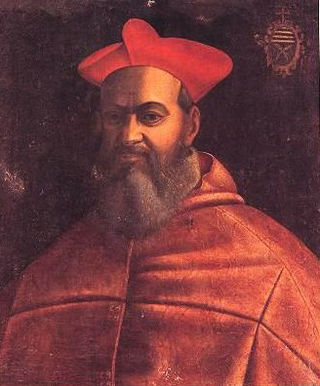
Scipione Rebiba was an Italian prelate of the Catholic Church, a protégé of Gian Pietro Carafa, who became Pope Paul IV. He held a variety of positions in the Church hierarchy, including some of the most senior. He introduced the Inquisition to Naples in the 1550s and became a cardinal in 1555. He is mostly known today for having been the earliest bishop to whom most Latin Catholic bishops can trace their apostolic succession, as it is currently unknown who consecrated Rebiba.
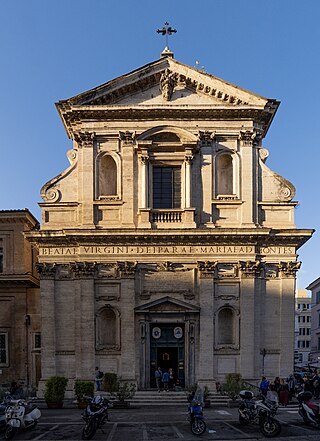
Santa Maria dei Monti is a cardinalatial titular church, located at 41 Via della Madonna dei Monti, at the intersection with Via dei Serpenti, in the rione Monti of Rome, Italy. The church is dedicated to the Blessed Virgin Mary.

Antonio Barberini was an Italian Catholic cardinal, Archbishop of Reims, military leader, patron of the arts and a prominent member of the House of Barberini. As one of the cardinal-nephews of Pope Urban VIII and a supporter of France, he played a significant role at a number of the papal conclaves of the 17th century. With his brothers Cardinal Francesco Barberini and Taddeo Barberini he helped to shape politics, religion, art and music of 17th century Italy. He is sometimes referred to as Antonio the Younger or Antonio Barberini iuniore to distinguish him from his uncle Antonio Marcello Barberini.

Santi Sergio e Bacco is a Catholic church of the Byzantine Rite located on Piazza Madonna dei Monti in the rione of Monti in Rome, Italy. Sergius and Bacchus are said to have been early fourth-century Roman military officers and Christian martyrs buried in Syria. In the 9th century the church was known as Sergius and Bacchus in Callinico, in the Middle Ages as Sergius and Bacchus de Suburra, and from the 18th century forward has been known also as the church of Madonna del Pascolo. Since 1970 it has been a national church of the Ukrainian Greek Catholic Church in Rome and was known officially as the "Parish of Ukrainian Catholics of Madonna del Pascolo and Saints Sergius and Bacchus." Since 2019 the church serves as a cathedral for the Ukrainian Catholic Apostolic Exarchate of Italy.

Guglielmo Sirleto was an Italian Cardinal and scholar. He was considered the greatest linguist of his age.

The Diocese of San Benedetto del Tronto-Ripatransone-Montalto is a Latin diocese of the Catholic Church in the Marche. It has existed in its current form since 1986. In that year the Diocese of Montalto was united into the Diocese of Ripatransone-San Benedetto del Tronto, which was the renamed historical Diocese of Ripatransone. The Roman Catholic Diocese of San Benedetto del Tronto-Ripatransone-Montalto has been a suffragan see of the Roman Catholic Archdiocese of Fermo since 1680.
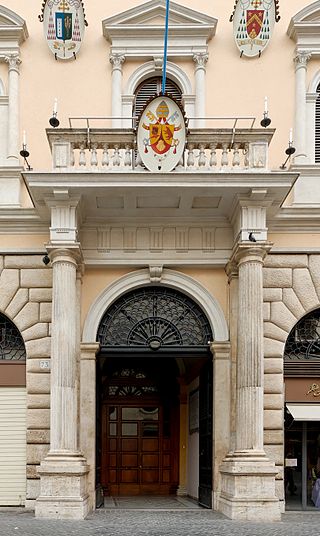
The Roman Colleges, also referred to as the Pontifical Colleges in Rome, are institutions established and maintained in Rome for the education of future ecclesiastics of the Catholic Church. Traditionally many were for students of a particular nationality. The colleges are halls of residence in which the students follow the usual seminary exercises of piety, study in private, and review the subjects treated in class. In some colleges there are special courses of instruction but the regular courses in philosophy and theology are given in a few large central institutions, such as Pontifical Urbaniana University, the Pontifical Gregorian University, the Pontifical Lateran University, and the Pontifical University of Saint Thomas Aquinas, known as the Angelicum.
The Pontificio Collegio Urbano de Propaganda Fide was established in 1627 for the purpose of training missionaries to spread Catholicism around the world.

The 1592 papal conclave elected Pope Clement VIII in succession to Pope Innocent IX.

Vincenzo Maculani was an Italian Catholic Cardinal, inquisitor and military architect. He was known as a severe man, harsh and without compassion, who preferred the black cappa of his order to the brighter red he was later entitled to wear as a cardinal.
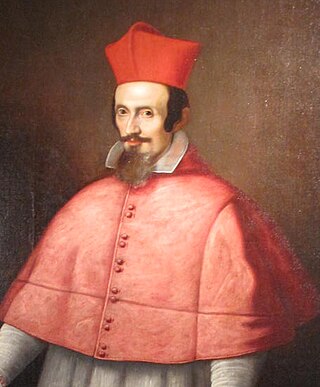
Cesare Monti was an Italian Cardinal who served as Latin Patriarch of Antioch and Archbishop of Milan.
Domenico Gerosolimitano, originally Rabbi Samuel Vivas of Jerusalem, was a notable ecclesiastical censor of Hebrew books. His Sefer Hazikkuk, the Hebrew equivalent of Index Expurgatorius, played an important role in the censorship of Hebrew books in the late 16th and early 17th centuries.

The Domus Internationalis Paulus VI was established as a Foundation by Pope John Paul II on 6 January 1999. The purpose of the Domus is to accommodate clergy who are assigned to the diplomatic service of the Holy See, or who are officials of the Roman Curia. The Domus is at the Southern wing of the Palazzi di S. Apollinare. It is a historic Palazzo located in the ancient centre of Rome, and one of the four residences of the Officials of the Roman Curia in Rome; the other three are Domus Sanctae Marthae within the Vatican Walls, the Casa San Benedetto at via dell'Erba, and the Domus Romana Sacerdotalis at via Traspontina. The last two are located near the St. Peter's Square. Cardinals, bishops and priests who visit the Pope in Rome or who participate in the various apostolic works of the Holy See also stay at the Domus. The Domus is near the Vatican, notable Roman monuments, and famous sights.
The Pontifical Greek College of St. Athanasius is a Pontifical College in Rome that observes the Byzantine rite.
AndreaDe Monte was a Moroccan Jewish convert to Christianity and missionary to the Jews at Rome.
References
- ↑ The history of the popes from the close of the middle ages: Volume 11 – Page 583 Ralph Francis Kerr – 1968 "Gregory XIII. endowed this with privileges and assigned it to the College of the Neophytes."
- ↑ Azariah de Rossi's observations on the Syriac New Testament. ed. Joanna Weinberg, Azariah ben Moses dei Rossi, Warburg Institute – 2005 "There is, on the other hand, a wealth of material regarding Giulio Antonio Santoro (1532–1602), a powerful and authoritative figure in the Rome of Gregory XIII. As 'Iudex sacrae Inquisitionis', and head of the Collegio dei Neofiti, .."
- ↑ The Jews of Europe and the Inquisition of Venice, 1550–1670 – Page 248 Brian Pullan – 1998 "As is well known, the conversion campaigns were developed under Pope Gregory XIII: in 1577 he founded the Collegio dei Neofiti to train converts for missionary work, and seven years later issued a Bull urging Christian authorities who ..."
- ↑ Lance Gabriel Lazar Working in the vineyard of the Lord: Jesuit confraternities 2005 Page 114 "The last piece of the puzzle came from the Capuchin cardinal Antonio Barberini (brother of Urban VIII, and supporter of S. Caterina as well), who in 1634 constructed the enormous Collegio dei Neofiti next door, and had the last .
- ↑ Nicholas Terpstra The politics of ritual kinship: confraternities and social order 2000 Page 147 In 1634, the Confraternity's Cardinal Protector, the Cappuchin Antonio Barberini (brother of Urban VIII), constructed the enormous Collegio dei Neofiti next door, and had the last Catechumens from S. Giovanni transferred there.
- ↑ Spain and its literature: essays in memory of E. Allison Peers 1997- Page 217 ed. Ann L. Mackenzie "Fr Giulio Bartolocci (1613-1687) was a Cistercian orientalist who became professor of Hebrew at the Collegio dei Neofiti in Rome, where he prepared his monumental Bibliotheca Magna Rabbinica (Rome: Ex typ. Sac. Congregado, 1675–1694)"
- ↑ Charles Cocquelines Bullarium Privilegiorum Ac Diplomatum Romanorum Pontificum 1760 Page 56 "Um alias piae memorise Julius Papa Tertius Praedecettor noñer in subventionem, et alimoniam pauperis Domus Neophytorum ad fidem catholicam convertorum , íéu cathecumenorum Urbis nuncup. decreverit, quamlibet Synagogam, adunantiam ..."
- ↑ Saverio Franchi Drammaturgia romana: repertorio bibliografico cronologico 1988 Page cxvii "Per il Collegio dei Neofiti alla Madonna dei Monti, dal 1713 affidato ai Pii Operai, mi sono note solo due cantate latine per laurea eseguitevi nel Seicento (cfr. IS pp. ..."
- ↑ Carlo Bartolomeo Piazza Opere pie di Roma, descritte secondo lo stato presente 1679 Page 224 "Del Collegio de Neofiti. Alla Madonna de Monti. Il Collegio de'Neofìti, cioè de' Cristiani novelli e nuovamente istrutti nella Religione Cristiana, fu da Gregorio XIII, con sommo zelo istituito l'anno 1577.
- ↑ Gaetano Moroni Dizionario di erudizione storico-ecclesiastica da S. Pietro 1847 Page 274 "Maria de' Monti con tutte le sue entrate, e con l'obbligo di tenere l'amministrazione del collegio dei neofiti e pia casa de'catecumeni, ferma sempre la giurisdizione del protettore. Verso questo tempo sembra che cessasse ogni cura ...
- ↑ Targum Neofiti 1, Genesis: : Volume 1, Part 1 Martin McNamara – 1992 "Canonicus Schuller, the last rector of the Domus. In 1543 Paul III founded a Domus Catechumenorum in Rome for converts from Judaism, and in 1577 Gregory XIII founded there the Pia Domus Neophytorum or, to give it its original title,
- ↑ View from the air, Rome Tourist Board website